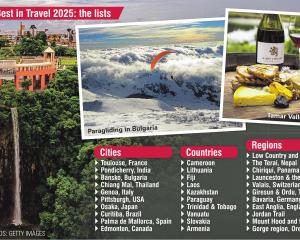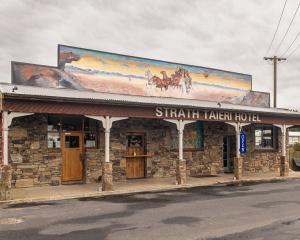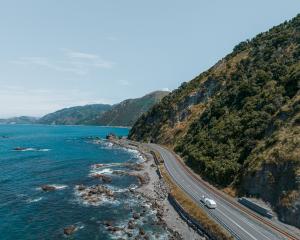"Good afternoon Sir. Off skiing are we?"
"Yes," I replied.
"To Canada or the US?" guessed the check-in worker at Christchurch Airport as I dumped my ski bag in front of her.
"No, Iran," I said.
With a laugh and a smile she took my passport and air ticket and proceeded to check me in.
Less than five seconds later her facial expression changed.
She glanced up at me with an almost confused look on her face and said: "You're not joking are you?".
Then came the questions.
"Isn't Iran a desert? Is it safe? Where are the ski fields?"The questions were not new to me.
For months I had tried to find friends interested in doing a ski trip to Iran but a lack of knowledge of the ski scene and the image of Iran in the West was enough for most to say, "No thanks".
However, a Dunedin friend living in London jumped at the chance.
Mark Taylor, an experienced traveller, has a passion for searching the far corners of the world with a pair of skis.
His email went along the lines of "are you serious?".
The reply was "yes", and so we started to plan our trip.
The hard work was in the planning.
Iran not being a major tourist destination, information was at times hard to come by.
First we needed to get a visa, which meant finding a sponsor in Iran.
We found a travel agent in New Zealand who could organise this, but the agency required that you book your whole trip through it from start to finish.
This was not an option for us, as on any ski trip the seasons can be good or bad and we wanted the freedom to be able to move around.
Having Mark living in London was a major advantage.
London, a major travel hub, has a range of companies that can help arrange the visa and will not tie you into organising the entire trip.
Mark went into investigation mode and soon found a company that provided good information, was helpful and cheaper than dealing with the companies we had quotes from in New Zealand.
Getting there was simple and not too pricey.
After a direct flight to Dubai with UAE, Teheran's new international airport was just a connecting flight away.
I felt I had more trouble getting out of New Zealand than getting into Iran.
Teheran's airport was clean, quiet and efficient.
I was greeted by what appeared to be a huge, stony-faced Persian warrior.
Without a word being said, he took my passport, examined it, then turned and gave me a huge smile and nodded me on my way.
We had left Dubai in 24degC temperatures to arrive to a cool -5degC in Teheran.
Settled on a high plateau (1300m), Teheran is one of the most polluted cities in the world, with little to offer from a tourist point of view.
We had two nights there but in hindsight really only needed one.
We took in a few of the sights, of which the National Jewels Museum was the highlight.
The day we were to leave Teheran for the slopes of Dizin we woke to find large snowflakes falling in the city.
Smiles formed on our faces as we anticipated what was to come.
Dizin is a 60km drive from Teheran in the Alborz mountain range.
Driving there can take two to three hours, depending on the traffic.
Why so long? Traffic in Teheran is something special.
I read a description of it as "organised chaos".
Traffic rules seem non-existent, but somehow everything seems to move.
We arrived late at night and to our dismay it had not snowed as much on the mountain as in the city, only a couple of centimetres, but it was cold, -15degC.
As morning broke on our first full day in Dizin we looked outside to find an overcast day with snow flurries.
It was, as expected, bone-chillingly cold.
The wind picked up and after our first few runs I had a laugh when I saw what I thought was snot frozen to the side of Mark's nose.
As it turned out, his nose had just turned a strange shade of yellow in the cold.
Dizin is one of the highest skifields in the world.
The highest lift reaches about 3600m.
To put this into perspective, Mt Cook is 3754m.
Iran's highest mountain, Mt Damavand, stretches to 5671m.
The skifield has about 850m of vertical drop, with a mixture of well-groomed slopes and big areas of off-piste skiing.
It is like a large Cardrona, a very large Cardrona.
There are three gondolas, a couple of chairlifts and a number of Pomas.
Set up mainly for intermediate skiers, it has something for everyone, from long rolling cruising runs to wide bowls and narrow chutes.
The light snow is excellent, as good as anything you would find in the US or Europe and somewhat better than we get in New Zealand.
We did not get any deep powder days, for which we had heard Dizin was famous, but what we did get was still a step up on New Zealand conditions.
The snow is dry as the humidity is low, so when you get in the powder you don't have to worry about it losing its quality.
This, combined with the fact the Iranians like to ski on-piste, gives you the opportunity to ski untracked runs days after the previous snowfall.
The queues are small during the week but come the weekend be prepared for anything from 20 to 40 minutes in line.
There are opportunities for the more advanced skier at Dizin, although another skifield, Shemshak, offers more.
Shemsak is a small town 12km from Dizin.
You can get there by taxi across a mountain road.
Be warned, this road is often closed if there has been a large snowfall.
If it is, you need to take the main road back through Teheran, which can turn a 10-minute taxi ride into a three-hour drive.
Shemshak is a smaller version of Treble Cone.
All the locals say it is for advanced skiers and the resort has a much more liberal feeling about it. Dance music is often loudly broadcast from the mid-field café.
All chairlifts leave from the base of the village.
Snow conditions are similar to Dizin, the noticeable difference being the gradient of the field and the resulting mogul field.
We found the people at Shemshak were more likely to engage you in conversation.
We soon met some locals who took us under their wing and showed us around the mountain.
The accommodation we encountered was basic.
We stayed in a hotel in Dizin.
The rooms were clean and had TVs (not that we understood anything).
The most impressive feature of our room was the high-pressure shower, which was always well-received at the end of a long day skiing.
Food was simple and good but somewhat limited in range.
The continental breakfast almost became painful to eat by the end of the week.
After much begging we did convince the chef to cook us an omelette.
Mark started ordering extra kebabs at night that he would then put in a doggy bag for breakfast.
The most impressive thing about Iran was the people and how safe the country was.
Iran gets plenty of negative press, but the fact is the people are extremely kind and welcoming.
The only thing visitors need be warned about is the aprés ski.
Be prepared to leave an Iran ski trip feeling as if you have been to a health camp.
There are no nightclubs or bars.
On the other hand, should you take some cards or board games, the locals will be happy to talk the night away.
James Smith is distribution manager at the Otago Daily Times.












